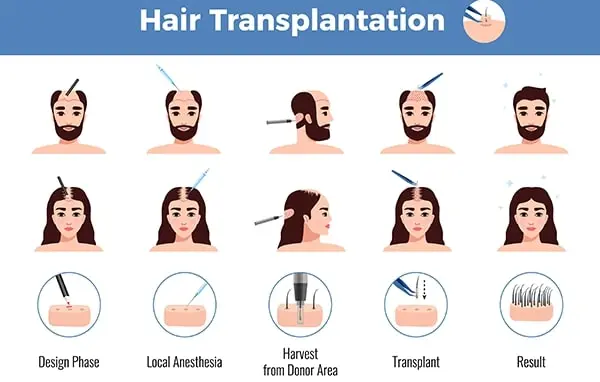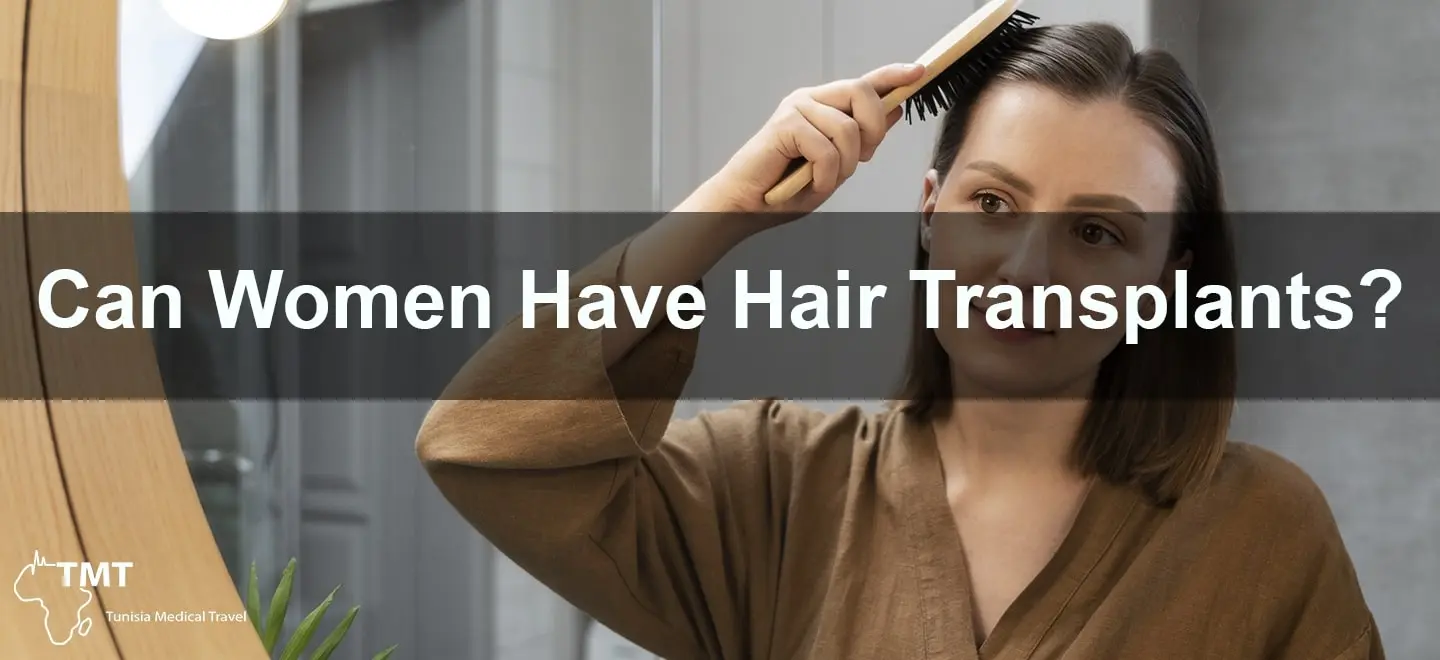Can Women Have Hair Transplants?
Can Women Have Hair Transplants?
What are some causes of female hair loss?
This can include women who are pregnant, have just given birth, or are going through menopause, and the cause may be hormonal. Dihydrotestosterone is often the cause for hair loss due to hormone change, and this type of loss will correct itself after the hormone levels go back to normal. This can also be the case for a woman who has been prescribed oral contraception. What if any of these women are good candidates for hair transplantation. The most common scenario for women is female pattern baldness. This represents a widow’s peak or a thinning of the front part and/or top of the scalp. It is usually genetic and can be inherited from either the mother or the father. Female pattern baldness often begins in the 40s and 50s.
How is hair loss in women diagnosed?
A general medical history form for use in all cases of hair loss would greatly simplify the evaluation process. A complete physical examination, including a check of the hair shaft and the distribution of hair loss, is also necessary. It is particularly important to rule out a structural or anagen hair shaft abnormality with its own distinct diagnosis and treatment. The hair pull test is a simple diagnostic tool to determine the nature of hair loss. It is a screening test to assess the shedding of hair in telogen effluvium. A small (60 hairs), defined area of the scalp is grasped between the thumb and forefinger and the hairs are firmly but gently pulled. Hairs that come out with the bulb attached to them represent active hair shedding. Up to 10% of the hairs can be in the telogen phase at one time, and telogen effluvium is present if more than 2-3% of those hairs are pulled out. Finally, a scalp biopsy is the most specific test to diagnose the cause of hair loss. The type of biopsy must be selected based on the differential diagnosis.
Diagnosing hair loss in women is more complicated than in men and requires careful evaluation. Often, women require more than one type of diagnostic test. Since hair loss is the first sign of many undiagnosed diseases in women with a multitude of symptoms, a detailed medical history is important. The medical history should include a history of diseases that cause hair loss, a history of hereditary factors, a history of temporary factors, a history of diet, and a history of medications.
Why are women ditching wigs for hair transplants?
Women are more active now and are less prepared to wear a wig forever. Many women are naturally quite skeptical, but once they have seen the results, they are happy to consider a hair transplant as a solution to their hair loss. The importance of hair to women is well known. Women invest lots of time and money pursuing the perfect style and look – hair plays a fundamental role in their confidence and self-image. Many women find that their hair loss has created a large dent in their confidence, with some reporting feelings of depression or anxiety. Wigs can act as a suitable short-term solution to hair loss, delivering a quick confidence boost. However, wigs are uncomfortable and are not a good long-term option. Increasingly, women feel that a wig acts as a mere covering for the problem, rather than a solution. They feel that their hair loss is an essentially medical matter and prefer a medical response. This is particularly relevant to women with hair loss due to scarring from accidents and cosmetic procedures or from various dermatological conditions. Such women feel that a wig fails to address the causal problem and so seek a more permanent and definite solution.
How many women get hair transplants every year?
100,000 women per year are candidates for hair transplant surgery. Traditionally, many women have tried to mask their hair loss using dyes, tints, perms, and artificial hair replacements. Often times hair on the top of the head is thinning allowing for an ideal situation for hair transplantation. However, many women with hair loss are not candidates for hair transplantation because of insufficient donor hair sites. The key to being a candidate for hair transplant is having hair in good, permanent sites such as the sides and back of the head. It is not necessary to shave the head for hair transplant and graft survival rates are high for the scalp compared to other hair bearing areas. Nevertheless, the visualization results offered to women who are good candidates can dramatically increase the quality of life.

Why aren’t female hair transplants as popular as male hair transplants?
The first reason is simply that hair loss for women isn’t as much of a social stigma as it is for men. Society more or less accepts it as a fact of life for many women, due to aging or other reasons. For men, it is much more of a problem, many teaching it as a sign of old age or loss of virility. A common prejudice against hair loss has resulted in men believing that a full head of hair is essential for appearing attractive to the opposite sex, and many employers have been accused of ageism or sexism if they show a bias towards younger men. This is probably the biggest reason for the general decline in hair transplant stigma for males. The lack of importance placed upon hair loss affects women’s decision upon having a transplant, as it is generally seen that one only goes for the procedure if they are deeply troubled about losing their hair. Of course, this may not be the only reason, and some women do feel very depressed about losing their hair, particularly younger sufferers. But it is fair to say that the overall lack of importance of hair loss in women affects the female hair transplant industry. Today, even women with significant androgenetic alopecia or another form of MPHL can be subjected to employers looking upon baldness as a sign of age, poor health, or poor attention to personal care.
A second reason is that female hair loss just isn’t noticed as much. A woman suffering from hair loss might try to hide the problem by using hats, scarves, and various hair systems. A little girl’s hair loss usually does not result in complete baldness; rather, there’s a general thinning of the hair. Female hair loss is often iconized in the media, typically by showing middle-aged women with a scalp clearly visible at the parting. But many women will never reach this stage, or will use various cover-up methods to hide the problem. The general lack of hair loss visibility results in fewer women feeling that they must seek surgical treatment. Younger women worried about their hair loss must also be aware that the transplant does not stop ongoing hair loss, and it can often be a traumatic process to undergo one—only needing another in the future. Cognitive behavior therapy can have more lasting results in these cases.
How does a hair transplant for women work?
Before starting any hair transplant surgery, a thorough consultation is done and the hair loss is discussed. It is tested whether Finasteride is a good fit for the woman. It’s important not to attempt surgery if the woman does not respond to Finasteride. Donor density is a big issue in women. If the hair loss is too much, it is considered a bad candidate for surgery. Women have what is known as « diffuse hair loss, » which means it is all over the head rather than in a specific area. It was discovered with men that transplanted hair on a bald spot takes on the traits of the hair that was originally there. This means that if the hair on the woman’s thinning areas is not « miniaturized » (a process where terminal hairs become soft and downy), then the transplanted hair will not be permanent in that area. So ideally, a woman who has a hair transplant would continue to take Propecia to keep the non-transplanted hairs from miniaturizing. This way, the transplanted hair would be surrounded by hair that has similar genetic traits and it would be shared by the same DHT.
With hair transplantation, achieving the right angle, direction, and orientation is extremely important. Also, the distribution of density and the use of single hairs versus multiple hair grafts is important. Steps should also be taken to minimize damage to existing surrounding hairs. The increased scarring and subsequent reduction in the number of procedures is a major downside to hair transplant surgery in women. This is due to the poor quality of the laxity of the scalp of the typical female pattern hair loss victim.
Do female hair transplants hurt?
Although the surgery should not be painful when performed by a physician with experience who is using the correct techniques and instrumentation, it is recognized that there are some persons more sensitive to medical procedures and there are some persons with low pain thresholds. What is important here is that patients always remember the long-term implications of their decisions concerning hair transplant compared to other types of surgery. In no other medical or surgical field has the phrase « no pain, no gain » been more pertinent than in the field of female cosmetic surgery to the scalp. This is quite simply, considering the high likelihood of a good cosmetic result for the rest of a woman’s life, a field where even if there is a temporary discomfort or disfigurement it is justified. Temporary pain or discomfort are acceptable trade-offs for success in providing a long-term or permanent solution to hair loss in women with any type of hair loss.
How is a female hair transplant procedure different from male hair transplant surgery?
A key reason for the difference is often the ‘donor area’ typically found in the back of the head. For men, harvesting hair from this area for transplanting often proves very successful, as this area of hair is less likely to be affected by DHT as it is genetically different to hair at the front or top of the head. Therefore, when hair is transplanted into the areas affected by MPB, the transplanted hair generally maintains its original characteristics, in terms of position, caliber, color, and texture. The patient, therefore, is likely to experience satisfactory results, often making a dramatic difference to his appearance and self-confidence. Occasionally, transplanted hair can lose some of these characteristics, especially if it is miniaturizing before it was shed and is therefore already affected by DHT. In this case, further loss of non-transplanted hair can create a patchy and unsatisfactory result, at which point further transplants may not prove successful.
For women, however, a similar delocalized loss of permanent hair around the front and top of the scalp does not make the back of the head a suitable donor area. This is because the type of hair in this area is sometimes immune to MPB, meaning that if it is transplanted to the affected areas, it will still be lost later on. If a woman has thick hair at the front and top of the scalp and only a very small area of DHT-affected hair at the very front, it may be possible to transplant hair to cover these affected areas. However, this is quite rare, and most women with female pattern hair loss will not be good candidates for hair transplant surgery.

